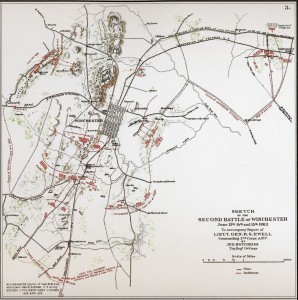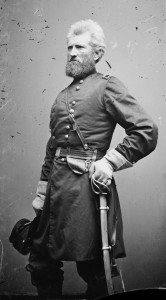A Visit to Winchester, VA
Posted By Jake Wynn on June 25, 2013
Few towns are as full of Civil War history as the small, but memorable Winchester, Virginia.
Today, the county seat of Frederick County sits at the confluence of several major roads, just as the town did during its Civil War years. War came to Winchester in 1862, 1863, and 1864. The historic courthouse in the town square witnessed the rise of “Stonewall,” the fall of a Union army, and the collapse of Rebel forces in the Shenandoah Valley.
As the sun beats down and the summer heat builds, the ghosts of Winchester’s war years to come to life. Structures dating back to the mid-1800s and earlier dominate the landscape of the town. A Confederate soldier standing more than 15 feet tall dominates the town’s center, in front of the courthouse.
People come from across the region to visit the town’s shops and restaurants and to walk through the well-populated Historic District. But the real draw, at least for me, is the Civil War history that oozes from every corner of this city. It would be a chore to find somewhere in this town where a Civil War soldier didn’t do something important.
The focus of this trip was the Second Battle of Winchester, which took place from June 13-15, 1863. The battle was among the first of the Gettysburg Campaign, shortly after the June 9 cavalry fight at Brandy Station.
General Robert H. Milroy commanded the Union Army’s VIII Corps stationed in the town of Winchester. The wartime population of Winchester stood at about 4,000 people, but that number swelled when the Union garrison of 7,000 men entered the town in the early months of 1863.
Two forts were built to guard the outpost at Winchester, both located on hilltops to the north and west of the town. When Robert E. Lee’s Army of Northern Virginia flooded into the Shenandoah Valley in early June 1863 en route to Pennsylvania, Winchester stood in his way. He commanded General Richard Ewell to destroy the Union garrison in his front.
Seeing that he was facing the full force of the Confederate army, Milroy pulled his troops back towards the forts. On June 14, the Confederate forces attacked, quickly overrunning the lower of the forts and shelling the second. Star Fort, as it was known, became the last holdout for Union forces, before it too was evacuated.

Retreating Union forces were surrounded and captured, with about 2/3 of Milroy’s command disappearing into the June twilight, along with 23 vital pieces of artillery. His retreating wagon train would leave Winchester and start the panic in Pennsylvania on the eve of the invasion of that state.
Lee’s forces would move up the Valley and invade the Cumberland Valley, thus beginning the Gettysburg Campaign in Pennsylvania.
Visiting Winchester today provides context to these stories. You can stand where soldiers and civilians stood in the perilous moments of 1863, when chaos again enveloped the small Virginian town.
 ;
;




This is amazing! Wish you would have stopped by, we were there last weekend of June. What a great map!